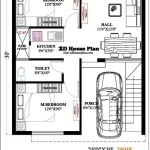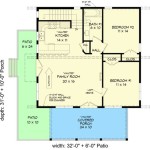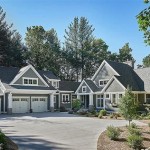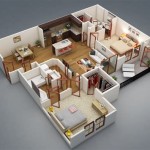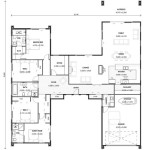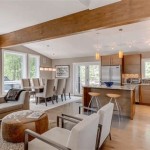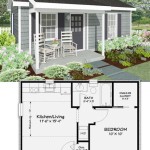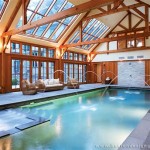Simple One-Bedroom House Plans: Maximizing Space and Functionality
The allure of a simple one-bedroom house plan lies in its efficiency and affordability. Ideal for single individuals, young couples, or retirees seeking a low-maintenance lifestyle, these designs prioritize functionality without sacrificing comfort. The success of a one-bedroom home depends heavily on strategic space planning, clever storage solutions, and a cohesive design aesthetic. This article explores key considerations when selecting or developing simple one-bedroom house plans, highlighting important aspects related to layout, functionality, and future adaptability.
When considering a one-bedroom house plan, it's crucial to remember that every square foot counts. Unlike larger homes where space might be allocated more liberally, a compact design necessitates careful consideration of each room's purpose and potential. The floor plan should facilitate easy movement, minimize wasted space, and create a sense of openness despite the limited square footage. The design's simplicity should not equate to a lack of detail; rather, simplicity should be viewed as a refined elegance that reflects a thoughtful and intentional approach to living.
Furthermore, the location of the one-bedroom house can significantly influence the overall design. Climate, terrain, and local building codes will all play a role in shaping the final architectural plans. For example, a house built in a warm climate might prioritize outdoor living spaces, while a home in a colder climate might focus on energy efficiency and insulation. Understanding these external factors is essential for creating a comfortable and sustainable living environment.
Optimizing Space and Layout
The layout is arguably the most critical element of a successful one-bedroom house plan. With limited square footage, the arrangement of rooms directly impacts the overall flow and livability of the space. Open-concept designs are often favored in one-bedroom homes, as they create a more spacious and airy feel. Combining the living room, dining area, and kitchen into a single, unified space eliminates unnecessary walls and maximizes natural light penetration. This approach requires careful consideration of zoning, ensuring that each area retains its distinct function while seamlessly blending into the overall design.
In addition to open-concept layouts, strategic placement of the bedroom is essential. While some plans position the bedroom directly off the living area, others opt for a more secluded location, providing greater privacy and noise reduction. The bedroom itself should be designed to maximize natural light and ventilation, creating a comfortable and relaxing retreat. Built-in storage solutions, such as closets and shelving units, are crucial for keeping the bedroom organized and clutter-free.
The bathroom should be conveniently located, ideally accessible from both the bedroom and the main living area. A well-designed bathroom can feel surprisingly spacious, even in a small footprint. Utilizing vertical space for storage, such as tall cabinets or shelving units, can help maximize functionality without compromising floor space. The choice of fixtures should also reflect the overall design aesthetic of the house, creating a cohesive and harmonious environment.
Another key consideration is the entry way or foyer. While a large foyer may not be feasible in a small house, a designated entry area can provide a place to remove shoes and coats, preventing dirt and clutter from entering the main living space. A small bench or storage unit can be incorporated into the entry area to provide both functionality and visual appeal. The goal is to create a welcoming and organized transition between the outside world and the interior of the home.
The kitchen layout is a crucial component of a one-bedroom house plan, especially if the design incorporates an open-concept living space. Efficiently designed kitchens maximize counter space and storage, making meal preparation a breeze. Common kitchen layouts include galley kitchens, L-shaped kitchens, and U-shaped kitchens, each offering different advantages depending on the available space and the homeowner's preferences. A well-placed kitchen island can provide additional counter space, storage, and seating, making it a versatile addition to the kitchen design.
Prioritizing Functionality and Storage
Functionality is paramount in a one-bedroom house, where every piece of furniture and every design element must serve a purpose. Multi-functional furniture, such as sofa beds, storage ottomans, and fold-away tables, can help maximize space and provide flexibility. These types of furniture allow the living area to easily transform from a daytime living space to a nighttime guest room, or from a dining area to a work space.
Storage solutions are essential for maintaining a clutter-free and organized living environment. Built-in storage, such as shelving units, cabinets, and drawers, can be seamlessly integrated into the walls and other architectural elements of the house. Vertical storage is particularly effective in small spaces, as it utilizes the height of the room to maximize storage capacity. Consider installing shelves above doorways, in hallways, and in other unused areas to create additional storage space.
In the bedroom, maximizing closet space is crucial. Custom closet organizers can help optimize the available space and create a more efficient storage system. Consider installing adjustable shelves, hanging rods, and drawers to accommodate different types of clothing and accessories. Utilize under-bed storage containers to store seasonal items, linens, and other bulky items.
The bathroom can also benefit from creative storage solutions. Wall-mounted cabinets, floating shelves, and recessed niches can provide ample storage space without taking up valuable floor space. Utilize the space under the sink for storage, and consider installing a medicine cabinet with a mirror to maximize functionality. A well-organized bathroom can feel surprisingly spacious, even in a small footprint.
Furthermore, consider incorporating outdoor storage solutions, such as a shed or deck box, to store gardening tools, outdoor furniture, and other items that are not needed indoors. A well-designed outdoor storage area can help keep the interior of the house clutter-free and organized.
Adaptability and Future Considerations
While a one-bedroom house may perfectly suit current needs, it is important to consider future adaptability. Life circumstances can change, and the house should ideally be designed to accommodate potential future needs. This might involve designing the space with the possibility of adding an additional bedroom or expanding the existing living area.
One strategy for enhancing adaptability is to design the house with a flexible floor plan. This involves creating spaces that can be easily reconfigured to suit different purposes. For example, a large living area could be divided into two smaller rooms, or a home office could be converted into a guest bedroom. The key is to create a design that is not overly rigid and can be easily adapted to changing needs.
Another consideration is the potential for adding an addition to the house in the future. When designing the initial floor plan, ensure that the structure can accommodate a future addition without compromising the existing design. This might involve reinforcing the foundation, ensuring that the roof can be easily extended, and planning for the integration of utilities.
The choice of materials and finishes can also impact the adaptability of the house. Select durable and timeless materials that will withstand wear and tear and remain aesthetically pleasing over time. Neutral color palettes provide a versatile backdrop that can be easily updated with new furniture and accessories. Sustainable and energy-efficient materials can also enhance the long-term value and appeal of the house.
Finally, consider the potential resale value of the house. While a one-bedroom house may be ideal for certain buyers, it may not appeal to everyone. Designing the house with future adaptability in mind can increase its appeal to a wider range of potential buyers, enhancing its resale value. A well-designed and maintained one-bedroom house can be a valuable asset, providing comfortable and affordable living for years to come.
In conclusion, designing a simple one-bedroom house plan requires careful planning, attention to detail, and a focus on functionality and adaptability. By optimizing the layout, prioritizing storage solutions, and considering future needs, it is possible to create a comfortable, stylish, and sustainable living environment that perfectly suits the needs of single individuals, young couples, or retirees. The key is to embrace the simplicity of the design and to create a space that reflects personal style and preferences.

Ranch Style House Plan 1 Beds Baths 896 Sq Ft 771 One Bedroom Plans Small Floor

One Bedroom House Plans For Starter Homes Ck

10 Best One Bedroom House Plans And Designs To Inspire You Co Ke

One Bedroom House Plans For Starter Homes Ck

Simple One Bedroom House Plans Bing Images Cottage Floor

1 Bedroom Apartment House Plans

1 Bedroom House Plan Examples

Affordable One Bedroom 700k Tiny House Plan Why Not Jenganami

25 One Bedroom House Apartment Plans

Ludicrousinlondon Com Small House Architecture Design Plans Blueprints

